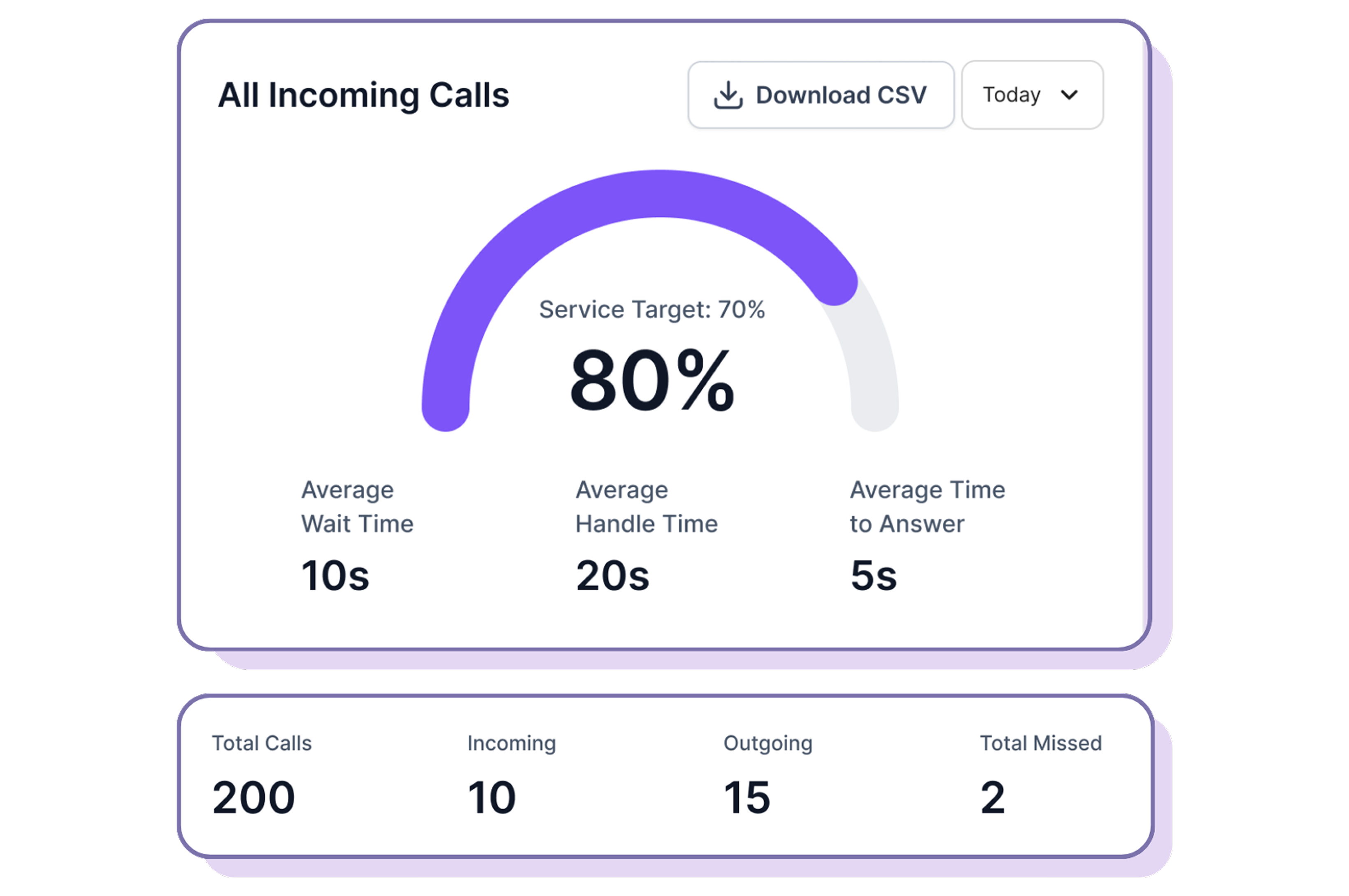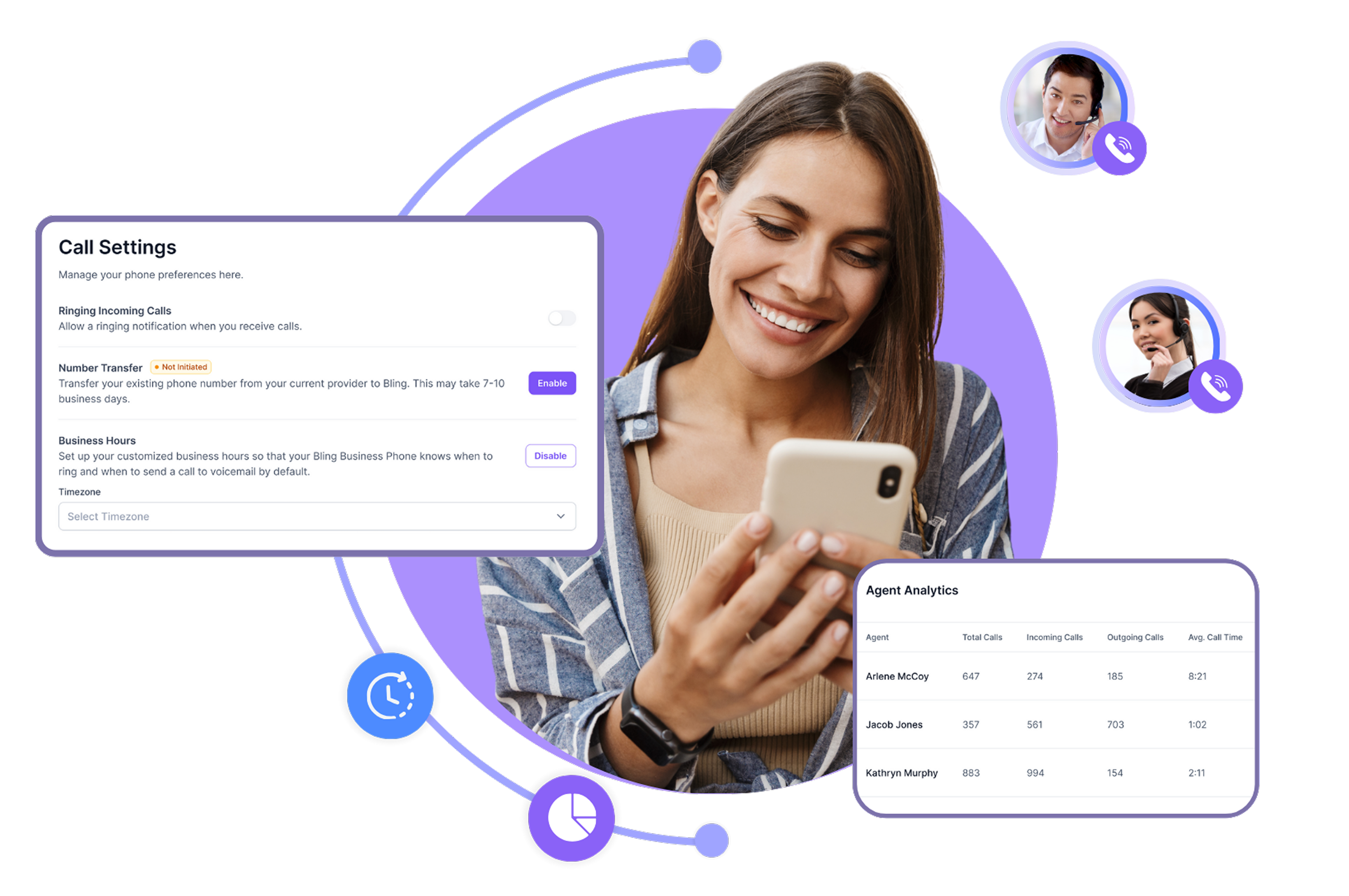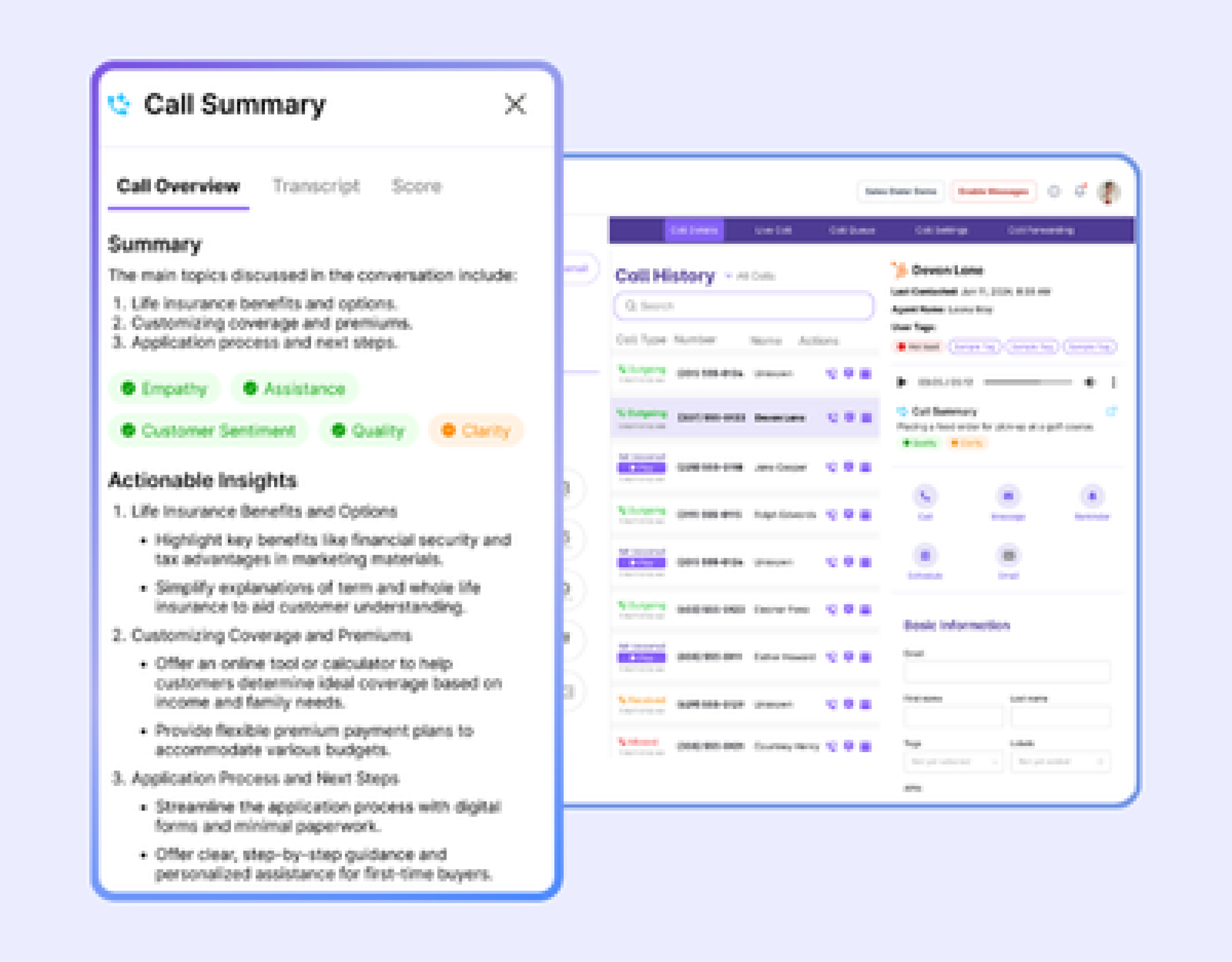Maximize call center ROI with the power of advanced analytics
Seamlessly connect Bling with your current systems to gain real-time analytics, enhance customer interactions, and optimize your communication processes with ease.

Seamlessly connect Bling with your current systems to gain real-time analytics, enhance customer interactions, and optimize your communication processes with ease.


Use Bling for detailed agent performance insights, real-time tracking, and seamless call queue optimization.
Bling's call recording and scoring system effectively highlight agent strengths and areas for improvement, allowing for personalized coaching to drive better performance.
Expand your business reach with toll-free numbers, making it easier for customers to contact you.
Leverage the queue analytics widget for real-time data to reduce wait times, improve caller experience, and enhance staffing efficiency.
Track and analyze call center data in real-time to ensure your team is always performing at its best, regardless of location.

Equip agents to provide outstanding service, boost customer retention, and strengthen team collaboration for enhanced productivity.
CRM integration boosts customer engagement by using data to refine agent training and enhance sales strategies.
Bling's sentiment analysis identifies customer dissatisfaction, helping reduce churn and improve retention.
Ring Groups route calls to the right departments, enhancing collaboration and connecting customers with the right experts quickly.
Call Monitoring and Recording
Monitor live calls and record them for evaluation, training, compliance, and performance improvement.
Analytics Dashboard
Centralizes call data, offering a real-time snapshot of team performance and detailed metrics.
Sentiment Analysis
Leverage AI to analyze customer moods through voice and speech, providing insights to improve service and support agent growth.
Intelligent IVR
Efficiently route callers to the right department or agent, improving service speed and accuracy.
Effortless CRM Integration
Integrate your voip phone service with your preferred CRM and tools, such as Zapier, HubSpot, PipeDrive, Salesforce, and more, streamlining your workflows and improving customer interactions.
Call Routing
Distribute calls based on your team's workload. Decide whether to ring multiple phones simultaneously or in a specific sequence.
Boost Outreach with Sales Dialer
Speed up your sales pipeline with dialing automation. Increase outreach and close deals faster than ever.
AI Transcript Analysis
Transcribe calls with AI to identify key moments and accelerate agent ramp-up for improved prospecting.
Call Forwarding
Redirect calls to your mobile or landline, ensuring you never miss an important call, anytime, anywhere.

Create your favorite Zap by clicking here
Speech analytics: Analyzes recorded calls to detect emotions, monitor agent performance, and assess call quality.
Text analytics: Analyzes written communications such as emails, chats, customer surveys, social media interactions, and support tickets to extract valuable insights and improve call center operations.
Predictive analytics: Forecasts future trends, call volumes, staffing requirements, customer behavior, and potential issues using historical data to enhance operational efficiency.
Interaction analytics: Analyzes customer and agent interactions to identify customer preferences and pain points, and improve operations.
Desktop and mobile analytics: Monitors performance and movement on desktop and mobile devices to identify inefficiencies and opportunities.
Cross channel analytics: Integrates data from multiple communication channels, such as phone calls, emails, chats, and social media interactions, to give a comprehensive view of customer calls and behavior across all touchpoints.
Self-service analytics: Analyzes customer interactions using channels like IVR systems, knowledge bases, and FAQs to minimize errors.
There are several key metrics that evaluate the performance of contact center operations. Some of these include:
Customer Satisfaction Score (CSAT): The level of satisfaction customers have with their interactions with the contact center. A high CSAT score is a good indicator of a positive customer experience.
Abandonment rate: The percentage of customers who hang up before their call is answered. A high abandonment rate is a sign that the contact center is not able to handle customer volume effectively.
Contact volume: The total number of interactions (calls, chats, emails, etc.) that the contact center handles.
Agent utilization: The percentage of time agents spend handling customer interactions, as opposed to other activities like training or administrative tasks.
Occupancy rate: The percentage of time that agents spend on the phone. A high occupancy rate is a good indicator of efficient and effective customer service.
Agent turnover: The rate at which agents leave the contact center. A high agent turnover rate can be costly and disruptive, and can negatively impact customer service.
Improved agent performance: Call center analytics provide data-driven insights that help agents manage their time better, refocus their efforts where needed, and identify effective sales pitches and support scripts. This reduces turnover by equipping agents with the tools they need to effectively manage workflows.
Increased sales: Call analytics identify customer behavior patterns, allowing agents to engage more personally and boost retention rates. Predictive analytics can directly improve sales by offering insights into effective communication strategies.
Better customer satisfaction: Modern customers expect fast, convenient, and customized service. Analytics help create accurate customer profiles and tailor interactions based on preferences like text, voice, or email. This personalization meets modern expectations and improves processes for common issues.
Identifying trends in customer behavior: Real-time analytics and alerts enable supervisors to monitor multiple conversations and use this information to build better processes and tools for handling customer interactions.
Customizable dashboards: Customizable dashboards allow supervisors to focus only on KPIs, spot trends early, and get customized real-time alerts and updates on their schedules. This helps them make informed decisions efficiently.
Better workforce management: Advanced analytics can improve workforce management by:
Data integrations: Your contact center software needs to be tightly integrated with your CRM, team chat, and email. Besides collecting quality data on agent performance and customer satisfaction, it also offers valuable insights for your team.
Instant access to call center metrics: Call data comes in many different forms and can be overwhelming without the right strategy in place. Your analytics software should have pre-built reports that connect to your most important business metrics. This helps turn data into actionable insights.
Real-time analytics for agents and supervisors: Look for a solution to provide real-time data to enhance the customer experience. These tools combine customer sentiment, call center performance, and business outcomes.
Beyond the call center, actionable insights should be offered when an inbound call reaches an employee’s phone.
Actionable insights along the customer journey: Use Contact Center as a Service software to track important performance metrics such as first response time (FRT), first contact resolution (FCR), average speed of answer (ASA), average handle time (AHT), call volume trends, and average waiting time.
Omnichannel support for customer satisfaction: Your contact center analytics software shouldn’t be siloed from the rest of the business. Look for a solution that integrates with other contact center data, such as:



Call center analytics is a type of call center tracking software that uses data-driven insights collated from call center operations. The idea is to evaluate performance, customer interactions, and overall efficiency.
By employing call center data analysis, businesses are better able to:
Bling's call center predictive analytics offers three-fold insights:
Conversation analytics captures and analyzes interactions between a brand and its customers across all channels, including phone, chat, SMS, email, web, and social surveys. It transforms the unstructured information in these interactions into structured data that can be analyzed.
With a deeper understanding of customers’ needs and emotions, companies can take proactive steps to improve customer experience and drive business improvement.